| |
|
|
Hiroshima
Peace Memorial Park
|
- November 1995 |
| |
|

|
The A-Bomb Dome (Genbaku-domu-mae) is one of the few
ruined buildings to be retained after the bombing.
Originally the Industrial Promotional Hall, it is a world famous symbol
of
the destructive power of the atomic bomb which flattened and burned
a city of 350,000 people, with about 140,000 people dying from injuries
and radiation within a few months of the bombing in August 1945. |
The Peace Memorial Museum contains very moving
displays of
the effects of the atomic bombing and maintains a watch on
the continued testing of nuclear weapons around the world.
In front of the building are the Statue of Mother and Child in
the Storm
and the Fountain of Prayer.
Colourful origami cranes are left on most of the memorials, monuments
and statues in the park as a symbol of visitors' wish for Peace. |

|
|
|
The Museum is seen beyond the Flame of Peace, its shape
symbolising hands held palm upwards.
The flame will burn until all nuclear weapons are removed from the Earth. |
The Memorial Cenotaph contains the register
of all
who have died as a result of exposure to the atomic bomb.
It now lists more than 180,000 people.
The arch over the stone coffin is a replica of an ancient haniwa
house,
shielding the souls of those who died.
Through its arch you can see the Flame of Peace
and the A-Bomb Dome.
The stone here is inscribed:
'Let all souls here
rest in peace,
for we shall not
repeat the evil'. |
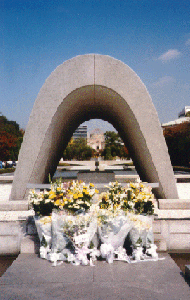
|
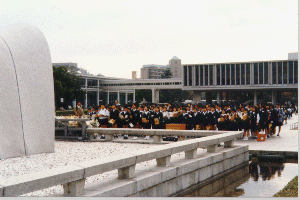
|
Children pray for Peace at the Cenotaph
with the Museum at rear. |
The Children's Monument is topped by
a statue of a girl holding a folded crane.
The statue is generally considered to represent Sadako Sasaki
whose death from leukaemia at age 12 moved her fellow students
to raise money for the monument from donors all over the world.
|
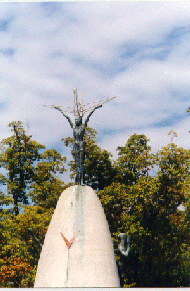
|

|
Sadako tried to fold a thousand paper cranes
so that her wish for a return to health might be granted.
Her school friends completed the folding after her death
and the folding of paper cranes has become a symbol
of a wish for Peace and a world free of nuclear weapons.
|
Sadako wrote of her cranes:
' I will write Peace
on your wings
and you will fly
all over the world.' |

|
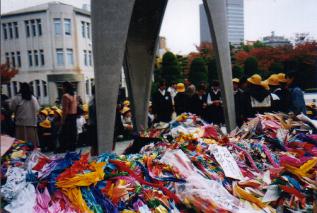
|
Around the base of the Children's Mounument
lie many thousands of folded paper cranes and
peace messages from all over the world. |
The painted banner reads Heiwa (Peace)
and
has folded cranes around its border.
Other Peace messages are spelt out in colourful cranes
pasted onto cardboard. |
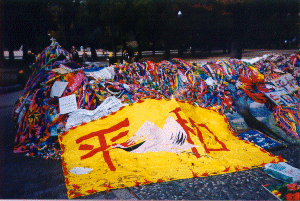
|
|
|
Every day hundreds of students come to pray at the
Children's Monument.
The inscription in stone here reads:
'This is our cry.
This is our prayer.
Peace in the world'. |
The Peace Bell is rung by visitors as
part of their wish for Peace.
The dome shape of the belfry symbolises the Universe.
The bell weighs more than a ton.
Around it wraps a map of the world with no national boundaries
shown, to symbolise 'One World'. |

|
|
|
The Monument to the Unknown Victims, modelled on
an ancient burial mound, contains the ashes of
about 70,000 unidentified A-Bomb victims.
It stands on the site of some of the first cremations
of A-Bomb victims, and became the resting place
of ashes brought from other parts of the city. |
The Monument to the Mobilised Students remembers
nearly 7,000
Hiroshima school students who died in the atomic bomb blast.
They were 'mobilised' to demolish wooden buildings for firebreaks,
to produce food and to work in factories for the war effort.
The statue represents the Goddess of Peace with eight doves.
Thousands of paper cranes are left here by visitors seeking a world
in which children can live without fear of nuclear weapons.
The sign reading 'Peace' is made of folded paper cranes
glued onto a board. |
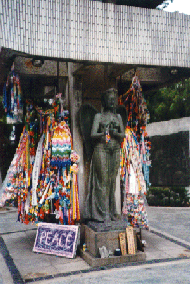
|
|
|
Modern Hiroshima rises beyond students sharing their lunch
with some of the thousands of doves which live in the Peace Park.
Doves are a symbol of Peace all over the world.
As a reminder that we must work to maintain Peace,
it is not uncommon to see birds of prey attacking the doves in flight
here. |
To remember the past is
to commit oneself to the future.
To remember Hiroshima is
to abhor nuclear war.
To remember Hiroshima is
to commit oneself to peace.
- Pope John Paul II 1981 |

|
![]() [ Thousand Cranes Peace
Network Home page ]
[ Thousand Cranes Peace
Network Home page ]  Back to the Thousand Cranes
Peace Network Home Page
Back to the Thousand Cranes
Peace Network Home Page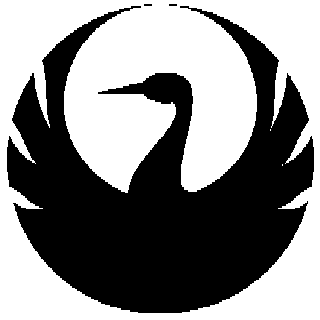 Join the network
Join the network  See what others are doing
See what others are doing 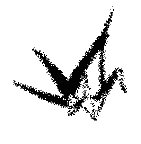
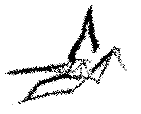
 Find out more about
Find out more about